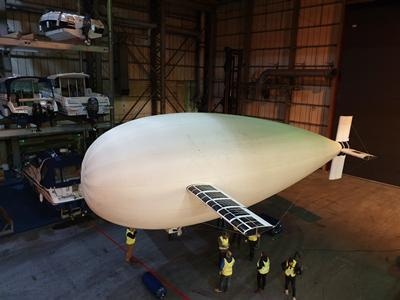Apr 25 2019
A new kind of unmanned aerial vehicle (UAV) successfully completed its maiden flight, thanks in part, to the proficiency of University of Southampton engineers.
 The Phoenix ultra-long-endurance aircraft spends half its time as a heavier-than-air airplane. (Image credit: University of Southampton)
The Phoenix ultra-long-endurance aircraft spends half its time as a heavier-than-air airplane. (Image credit: University of Southampton)
The Phoenix measuring 15 m in length and 10.5 m in wingspan is the first large variable-buoyancy-powered UAV in the world. Looking like an airship with wings, in appearance, the ultra-long-endurance aircraft spends one half of its time as a heavier-than-air airplane and the other half as a lighter-than-air balloon. It is the frequent transition between the two which offers the single source of propulsion for the Phoenix’s projected use as a pseudo-satellite.
Under a project sponsored by Innovate-UK approved by the Aerospace Technology Institute, and uniting SMEs, High Value Manufacturing Catapults and Academia, the ultra-long-endurance airplane applies the concept of variable-buoyancy propulsion that has been manipulated earlier for underwater remotely-operated-vehicles (ROVs) but has never before been used effectively for the propulsion of a large-scale aircraft.
The fuselage is built using a Vectran-based woven material and contains ~120 m3 of Helium, offering enough buoyancy to make the total vehicle lighter than air and rise like a balloon.
Inside the fuselage is a separate airbag with a capacity of 6 m3. Pumps situated at the mouth of this airbag are designed to inhale and compress air from outside and thus add weight (without changing the displacement) adequate to surpass the buoyancy.
This changeover to heavier-than-air flight enables the aircraft to descend in the same manner as a conventional airplane. The release of the compressed air allows it to get back its lighter-than-air configuration and the process is repeated. The forward inclination of the lift/buoyancy vectors with regards to the flight path, and the expulsion of the compressed air via a rearward facing vent, offer a thrust force that pushes the airplane forward without the need for any other form of propulsion.
The energy required to run the pumps, actuate the valve, and move the flight-control surfaces is supplied by a rechargeable battery built under the leadership of Southampton Professor Andrew Cruden, Head of the University’s Energy Technology Group, and colleague, Associate Professor, Dr Richard Wills. The battery pack is charged by a range of lightweight, flexible solar cells spread across the Phoenix’s upper surfaces of the wings and the horizontal tail.
The University of Southampton team within the School of Engineering developed a specific lithium-ion battery pack for this UAS, capable of operation across the wide range of temperatures found at altitude, and communicating the status of the pack to the automatic flight control system. The battery is designed to capture and store sufficient energy from the flexible photovoltaic arrays to power the UAS during the hours of darkness, with a safety margin for periods of poor weather and emergency use. This project was a substantial collaborative effort by all partners and it delivered a real sense of achievement to witness the successful flight after nearly 30 months of design, manufacture, assembly, and testing. It is anticipated this unique UAS will provide a substantially lower cost route to providing long endurance, zero emission pseudo satellites for communication, surveillance and humanitarian missions around the globe.
Andrew Cruden, Professor and Head of Energy Technology Group, Southampton University.
In March 2019, the prototype airplane was flown effectively and repetitively during indoor flight trials under the command of a completely autonomous flight control system across a distance of 120 m (the length of the Drystack facility, Trafalgar Wharf, Portsmouth used for the trials) making about five transitions in each flight.
The fuselage preserves its firmness through internal pressure and the structure of the flight surfaces uses carbon-fiber sandwich panels for the ribs, carbon-fiber spars and a lightweight skin. The wings store two ailerons and the cruciform tail comprises of pairs of rudders and elevators. A reversible hydrogen fuel cell has been created to augment the power system on future models.
The Phoenix project collaborators are SMEs: Banks Sails (fuselage materials and manufacture); TCS Micropumps (pumps and valves, computer aided design, and flight control actuators; Stirling Dynamics (flight control system). IQE plc headed the development of flexible photovoltaic cell technology.
Three of the UK’s High-Value Manufacturing Catapults also participated—The Centre for Process Innovation (project management and photovoltaic cells), The Manufacturing Technology Centre (flight control system and hardware testing), and The National Composites Centre (wing skins, carbon-fiber wing and tail structures, and the gondola).
Partnering Southampton as university participants are the University of Bristol (wing skins, carbon-fiber wing and tail structures, and the gondola), University of Newcastle (reversible hydrogen fuel cell), University of the Highlands and Islands (platform and flight control surface design), and the University of Sheffield (wind-tunnel testing).